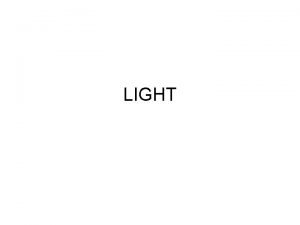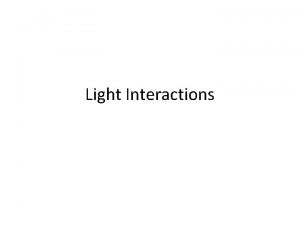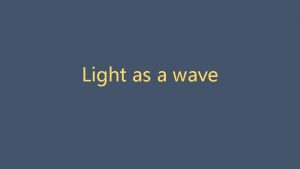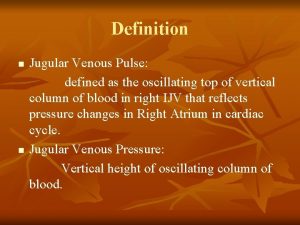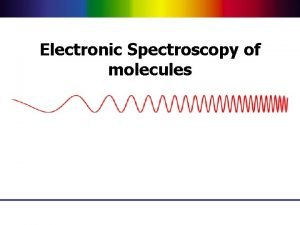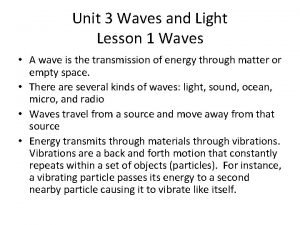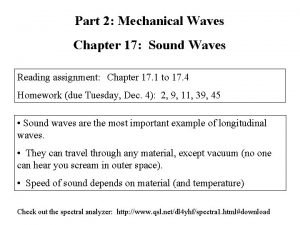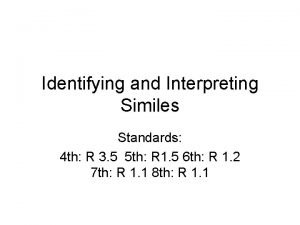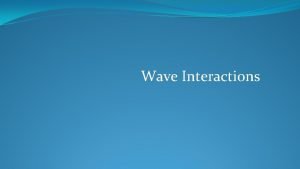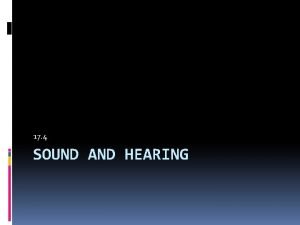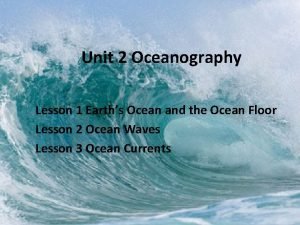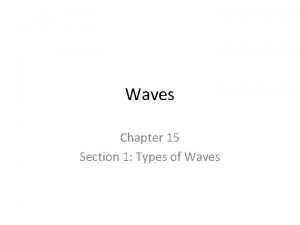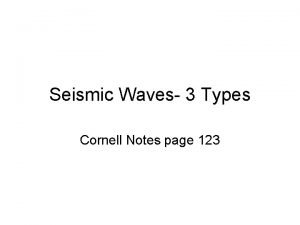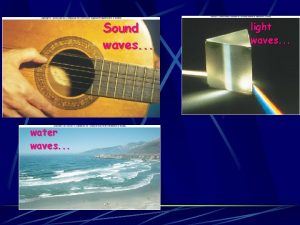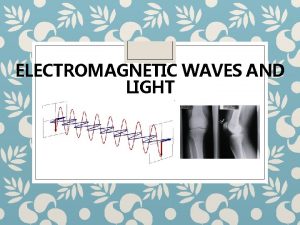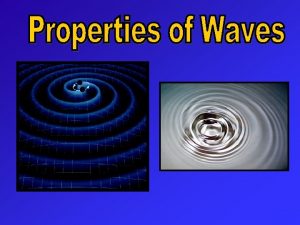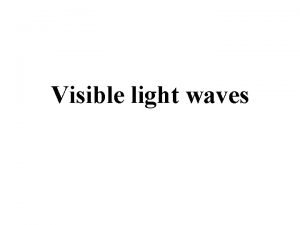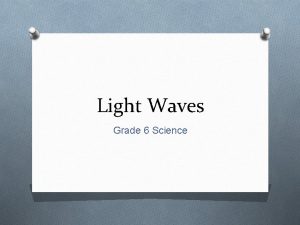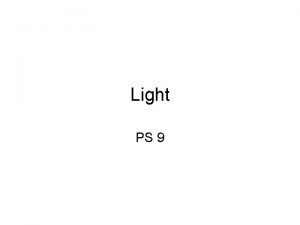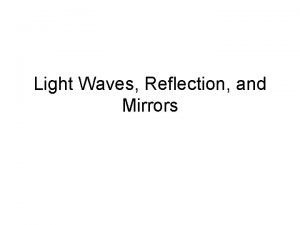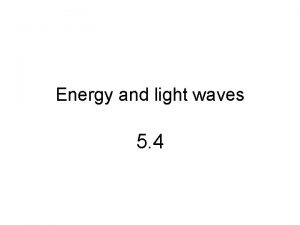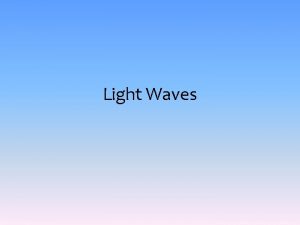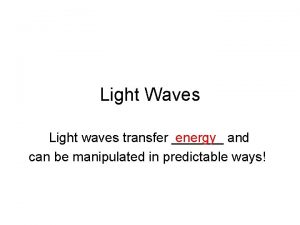Light Waves What is Light n Light is








































- Slides: 40

Light Waves

What is Light? n Light is the range of frequencies of the electromagnetic spectrum that stimulate the retina of the eye.

Physics Reference Table Visible light – a narrow slice of the spectrum Frequencies shown below colors

What is light made of? n Photons – little particles (quanta) of light n The higher the energy, the more light acts like this • Gamma rays, ultraviolet light n Visible light has characteristics of both n Waves – light travels in a diffuse path outwards from the source n The lower the energy, the more light acts like this • Radio waves

Light n n n Reflects Is absorbed Refracts

Light & Matter n n n Transparent (Glass): Materials that allow light to pass through without distorting images. Translucent (Cloudy Glass): Materials that allow light to pass through them, but do not allow them to be seen clearly. Opaque (Brick): Material in which all light is absorbed or reflected. No light is transmitted through.

Reflection and Absorption of Light and Color n The color observed by any object is the same as that not absorbed by the object. For example, a red block will absorb all colors of the EM visible light spectrum except for red. n How does this apply to the clothes we wear?

Law of Reflection n The angle of incidence with respect to the normal is equal to the angle of reflection.

Specular & Diffuse Reflection (Regular? ) n n Light incident upon an object with a smooth surface will create specular reflection. Light incident upon an object with a rough surface will create diffuse reflection.

Continuous Waves n n n When a wave impacts a boundary, some of the energy is reflected, while some passes through. The wave that passes through is called a transmitted wave. A wave that is transmitted through a boundary will lose some of its energy. n n Electromagnetic radiation will both slow down and have a shorter wavelength when going into a denser media. Speed of Light in different media

Continuous Waves – Lower Speed to Higher Speed Note the differences in wavelength and amplitude between of the wave in the two different mediums Incident + Reflected Wave Transmitted Wave v 2 -v 1 Displacement n Boundary Lower speed Higher speed Shorter wavelength Longer wavelength

Continuous Waves – Higher Speed to Lower Speed n Note the differences in wavelength and amplitude between of the wave in the two different mediums Transmitted Wave v 2 Displacement Incident + Reflected Wave -v 1 Boundary Higher speed Lower speed Longer wavelength Shorter wavelength Note: This phenomena is seen with light traveling from air to water.

Refraction of Light n n When light travels through a surface between two different media, the light will be refracted if the angle of incidence is greater than zero. If light is passing into a more dense media, it will bend towards a normal with the boundary.

Wave speed, frequency, and wavelength Remember v = f n When moving from one medium to another, if the frequency is driven by some external source, and the velocity v decreases, the wavelength also decreases and v/ = f on both sides of the boundary. So f = v 1 / 1 = v 2 / 2 = f n Medium 1 (vacuum) v = c Medium 2 (not vacuum) v < c

Wave speed, frequency, and wavelength f = v 1 / 1 Medium 1 (vacuum) v = c f = v 2 / 2 Medium 2 (not vacuum) v < c So f = v 1 / 1 = v 2 / 2 and 2 / 1 = v 2 / v 1 We call the ratio of v 2 / v 1 the relative index of refraction, n. If medium 1 is a vacuum (and v = c, the speed of light), then n is called the absolute index of refraction.

Index of refraction n When a light wave moves from one medium to another it bends, and the angle it bends is related to the index of refraction. How do we figure out how much it bends? n For two media, n n 2/n 1 = v 1/v 2 = sin. Q 1 / sin. Q 2 where Q is measured from the normal to the surface.

Speed of Light and the Index of Refraction n n The index of refraction, by definition, is the ratio of the speed of light in a vacuum to the speed of light in a substance. The index of refraction is always greater than 1 for any medium other than a vacuum (since light is always slower in any medium other than a vacuum).

Physics Reference Table

Refraction through a rectangular prism https: //www. youtube. com/watch? v=Oi. EWAAJBNi. U

Law of Refraction (Snell’s Law) n The ratio of the sine of the angle of incidence to the sine of the angle of refraction is a constant. n 1 sin 1 = n 2 sin 2 n Where: n 1, n 2 = index of refraction 1 = Angle of incidence 2 = Angle of refraction Note, the incident ray will always bend towards the normal when transitioning from a material with a lower index of refraction to one with a higher index of refraction. www. sol. sci. uop. edu

Law of Refraction (Snell’s Law) n The ratio of the sine of the angle of incidence to the sine of the angle of refraction is a constant. Where: n 1, n 2 = index of refraction 1 = Angle of incidence 2 = Angle of refraction n 1 sin 1 = n 2 sin 2 n 1 and 1 are on one n 2 and 2 are on the side of the interface other side of the interface www. sol. sci. uop. edu

Total Internal Reflection n n When the angle of incidence is such that the angle of refraction is equal to 90 o, the critical angle ( c) has been attained. All rays will be reflected internally at all angles greater than this angle. c = sin-1 (n 2/n 1) n n Note: Internal reflection can only occur if n 2 < n 1. 2 1 Internal Reflection Application – fiber optic cable https: //www. youtube. com/watch? v=Dlc cr 5 P 4 nww 1 2 www. micro. magnet. fsu. edu


Refraction and Reflection at a Boundary Normal refraction Refraction at Qcr (Air) N=1 N = 1. 33 (Water) Normal line Total Internal Reflection

Have you ever seen this?

Mirages can happen at any time of the year, but they are more commonly seen during the summer due to the hotter temperatures. The temperature difference between the layers of air is more important to the formation of a mirage than the actual temperature. The greater the difference in temperature the greater the bending effect.

Science (cont. ) There are two types of mirages. Superior and inferior mirages. Mirages are caused by light rays passing through a layer of hot air near the surface. This causes a bending effect. When the light rays are refracted a mirage is created.

Light Passing Through Glass Reflected Ray Air Glass Refracted Ray θ 2 θ 4 θ 3 θ 1 Incident Ray Note: 1 = 4 2 = 3 The light exiting the glass is parallel to the light entering it.

Light Passing Through Glass Light moving from a “fast” medium (low n) to a “slow” medium (high n): ___refracts toward the normal ___refracts away from the normal ___does not refract Light moving from one medium (n) to another medium (same n): ___refracts toward the normal ___refracts away from the normal ___does not refract Light moving from a “slow” medium (high n) to a “fast” medium (low n): ___refracts toward the normal ___refracts away from the normal ___does not refract

Sunset is an illusion

Chromatic Dispersion n n When white light enters a medium, the different wavelengths that comprise the light will travel at different speeds. If the angle of incidence is greater than zero, the wave will exhibit chromatic dispersion. Note: The shorter the wavelength, the greater the bending. What happens to the frequency? n NOTHING www. physics. uiowa. edu

Diffraction of Light n When a wave front is incident on a barrier with an opening, the wave will spread out after crossing the barrier. This process is called diffraction. n Diffraction is an interference phenomena. n As the slit becomes narrower, the amount of diffraction will increase. As the wavelength of light increases, the amount of diffraction will increase. Diffraction n Fingertips! n n

Is light a Wave? n Young Double-Slit Experiment: n n n The wave properties of light were first demonstrated by Thomas Young in 1801. Showed that light undergoes interference in and diffraction in much the same way that water and sound waves do. Used a source of monochromatic light so that only one wavelength was chosen. Also used light with no phase difference.

Young Double-Slit Experiment Huygen’s Wavelets www. src. wits. ac. za

Young Double Slit Experiment www. hyperphysics. phy-astr. gsu. edu

Young Double Slit Experiment Single Slit Pattern Double Slit Pattern

Key Ideas n n Transverse waves such as electro-magnetic radiation do not require a medium. Light Waves travel at different speeds in different mediums. It slows down when going from air to a liquid or solid. Waves can interfere with one another resulting in constructive or destructive interference. The law of reflection states that angle of incident wave equals the angle of the reflected wave.

Key Ideas n n Snell’s Law / Law of Refraction: A wave will bend toward the normal when transitioning from a media with a low index of refraction (e. g. air) to a media with a higher index of refraction. Total internal reflection occurs when the angle of incidence is greater than the critical angle. Consequently, no light will escape. Diffraction is the spreading out of a wave when it encounters a barrier. Thomas Young’s double slit experiment showed that light has wave properties similar to water and sound.

Young Double Slit Experiment (delta) = r 2 – r 1 n If r 2 – r 1 is equal to some multiple of , then the image on the screen will be a maximum (constructive interference). n If we assume that D is very big and r 1 and r 2 are parallel, then the angle between them will be . = d sin r 2 or m = d sin r 1 d D

Young Double Slit Experiment n n To determine the distance y between the central and first maximum, we will again assume that D is very large compared to y or d. From the diagram, we see that tan = y/D However, for small angles of , tan = sin Therefore, we r 2 can substitute y y/D for sin r 1 and get: d D
 Light is an electromagnetic wave true or false
Light is an electromagnetic wave true or false Aimtoknow
Aimtoknow Difference between matter waves and electromagnetic waves
Difference between matter waves and electromagnetic waves Seismic waves are mechanical waves
Seismic waves are mechanical waves The wave chapter 13
The wave chapter 13 Mechanical vs electromagnetic waves
Mechanical vs electromagnetic waves Differences between mechanical and electromagnetic waves
Differences between mechanical and electromagnetic waves Compare and contrast p waves and s waves using venn diagram
Compare and contrast p waves and s waves using venn diagram Sound waves longitudinal waves
Sound waves longitudinal waves Similarities of mechanical and electromagnetic waves
Similarities of mechanical and electromagnetic waves Mechanical and electromagnetic waves
Mechanical and electromagnetic waves What do all waves transmit
What do all waves transmit Carbon dioxide temperature
Carbon dioxide temperature Surface waves and body waves
Surface waves and body waves Difference between electromagnetic and mechanical waves
Difference between electromagnetic and mechanical waves Light light light chapter 23
Light light light chapter 23 Into the light chapter 22
Into the light chapter 22 Chapter 22
Chapter 22 Light waves
Light waves A lens that bends light waves inward
A lens that bends light waves inward Rays chart
Rays chart Do all em waves travel at the speed of light
Do all em waves travel at the speed of light Do light waves transfer energy
Do light waves transfer energy Block light in science
Block light in science Othello put out the light
Othello put out the light Bacteria double membrane
Bacteria double membrane The bouncing off of light
The bouncing off of light Neck veins waves
Neck veins waves Electromagnetic waves table
Electromagnetic waves table Waves classification
Waves classification Chapter 17 mechanical waves and sound
Chapter 17 mechanical waves and sound Edward 2
Edward 2 Beach simile
Beach simile Earthquake
Earthquake Waves can undergo
Waves can undergo Easterly waves
Easterly waves P waves
P waves Sound waves
Sound waves Current pattern
Current pattern Chapter 15 section 1 types of waves answer key
Chapter 15 section 1 types of waves answer key P and s waves difference
P and s waves difference



















